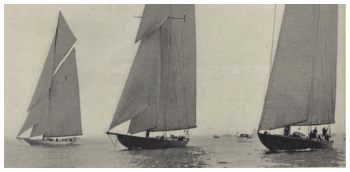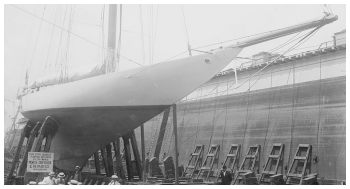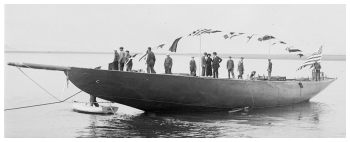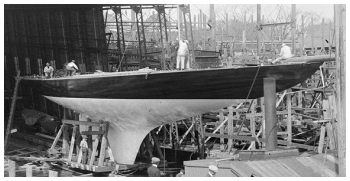Yves GARY Affichages : 1200
Catégorie : 1920 : DEFI N°13
 Construction, Plans de Voilure et Principales Caractéristiques des Trois Defenders de 1914.
Construction, Plans de Voilure et Principales Caractéristiques des Trois Defenders de 1914.© 1914 SCIENTIFIC AMERICAN, INC : MAY 2, 1914 - NOW that the British challenging yacht and the three cup defenders are plated up and practically ready for launching, all of them having long passed the stage when any knowledge by the designers of the plans of their competitors, would come too late to have ...
... any effect upon the final issue, the SCIENTIFIC AMERICAN takes much pleasure in presenting to its readers the first authentic information regarding the three cup defending yachts. That so much authentic technical information should be available for publication upon a subject in which the American public is so vitally interested, is an encouraging sign of the times. The old policy of maintaining profound secrecy, long after it has ceased to be necessary, has happily passed away, and the public is to be congratulated on the more liberal and sportsmanlike policy which recognizes the widespread national interest in the struggle for the "America's" cup.
The three yachts have been designed under the new rule of measurement which will govern this year's series of races. This rule was drawn up with the object of correcting the defects of the old rule. Under the old rule there was a tax on waterline length and sail area and on nothing else. Provided the yacht did not exceed 90 feet on the waterline, the designer might make her as broad, as deep, and as long on deck as he pleased; and he was at liberty to give her as large a sail plan as he wished. In determining the rating of the yacht, that is, the allowance she must give to or receive from a competitor, the waterline length and the sail area, only, were taken into consideration. The greater her waterline length, the larger her sail area, the greater would be the allowance which she had to make over a 30-mile course to her competitors. These were the only restrictions. Working under this rule, it was found that a yacht with a broad, shallow and generally scow-shaped hull, with long overhangs, carrying a great mass of lead at the bottom of a deep keel, and driven by a vast spread of sail, produced the fastest yacht under the average weather conditions off Sandy Hook. The most extreme yacht built under the rule was the "Reliance," which, on a waterline length of just under ninety feet, was over one ,hundred and forty feet in length on deck, and spread the enormous sail area of over sixteen thousand square feet of canvas. The bilges were hard and carried well out into the ends, the turn at the garboards from the floor into the keel was sharp; and it was the boast of Nat Herreshoff, her designer, that the "Reliance" had the largest sail area in proportion to the wetted surface of the hull of any yacht that had ever been built.
The racing yachts built under this rule lost their usefulness as soon as the cup contests were over. Their spars were too big, and their hulls too shallow, and their draft too great, to render them useful as cruisers; and most of those which were built for the last four series of races had to be broken up and sold for junk.
The changes introduced under the new rule were in the direction of producing a more wholesome boat, with a larger displacement, a smaller draft, a sweeter form with sharp ends, a form which would have a much easier motion in a seaway than the old scow form, which pounded heavily and was extremely wet in going to windward in a short sea.
A comparison of the cross sections of the three challengers of the present season shows the modifying effect of the new rule. The bilges are easy, the deadrise of the floor is steeper and the turn into the keel at the garboards is much fuller than in the yachts built under the old rule.
The new rule favors displacement; that is to say, the yacht with the larger displacement, other things being equal, will have the smaller rating and the larger time allowance. Considered from every point of view, the cup yachts of the season 1914 are much abler and more satisfactory sea' boats than their predecessors of the last four or five contests for the cup. Although the construction is very light, the materials have been so well disposed that the yachts are amply strong for the work they will have to do. Moreover, they will be available, when the races are over, for the regular yacht club regattas which are annually held on our coasts. If their future owners wish to turn them into cruisers, there is sufficient head room to enable the interior of their hulls to be bulk headed and furnished with the necessary cruising accommodations. A reduction in sail plan can be made without any serious reduction of the speed, and the boats can be handled, under this reduced rig, with crews of moderate size.
![DIMENSIONS.OF THE THREE CUP DEFEN])ERS](/images/stories/1920/Dim3Def.jpg) In respect of two of the principal dimensions the three yachts are alike. Each is 74 feet 9 inches in length on the load waterline, and the draft of each is 13 feet 9 inches. Also, there is not much difference in the beam, only one foot, in fact, between the narrowest, "Resolute," and the widest, "Defiance," whose width is, respectively, 21 feet 6 inches and 22 feet 6 inches. "Vanitie" comes between with a beam of 22 feet.
In respect of two of the principal dimensions the three yachts are alike. Each is 74 feet 9 inches in length on the load waterline, and the draft of each is 13 feet 9 inches. Also, there is not much difference in the beam, only one foot, in fact, between the narrowest, "Resolute," and the widest, "Defiance," whose width is, respectively, 21 feet 6 inches and 22 feet 6 inches. "Vanitie" comes between with a beam of 22 feet.
Of all the drawings, the most interesting and instructive is that showing the midship cross sections superimposed. From this it will be seen that "Resolute" has the fullest and deepest underwater body, with an easy bilge, steep floor, and a full turn from the floor at the garboards into the keel. "Vanitie" shows the least departure from the yachts built under the old rule; and, of the three boats, her bilge is harder, her floor flatter, and she is more cut away at the garboards, where the turn from floor to keel is rather sharp. "Defiance" shows a cross-section midway between the two. The effect of these midship sections is shown in the other dimensions of the hulls. Thus "Resolute" has much shorter overhangs than the other two boats, both forward and aft, her over-all length on deck being only 106 feet 5 inches, as against 115 feet in "Defiance" and 119 feet in "Vanitie". Speaking broadly, it may be said that while the differences in midship section are not very great, "Vanitie" suggests something of the U-section and "Resolute" the V-section, with the "Defiance" midway between the two. There is probably not much difference in the displacement of the three yachts, which is something over one hundred tons. The Gardner boat, "Vanitie," with her harder bilges shows a more powerful form than Nat Herreshoff's "Resolute," and in reaching and running, or at any time with sheets started, she should be the faster boat. In windward work, and particularly in a confused sea, we should incline to favor the chances of "Resolute."
The most interesting feature of difference in the three yachts is the sail plan, and it will come as a matter of surprise that the Herreshoff boat carries a spread of sail which is surprisingly less in area than that of the other two yachts, the "Resolute" spreading 8,188 square feet, "Vanitie" 9,465 square feet, and "Defiance" 9,819 square feet, or 1,631 square feet more than the Herreshoff boat.
The modern tendency to make the rig lofty and relatively narrow is shown in the sail plan of each yacht, and this is particularly noticeable in "Defiance." "Resolute" on a base line of 131 feet has a vertical height from main boom to topmast truck of 125 feet ; "Vanitie" on a base of 144 feet 6 inches shows a vertical height of 131 feet, whereas "Defiance" on a base line of 134 feet 6 inches has the enormous height of 146 feet. Both "Resolute" and "Vanitie" carry double headsails, and the division of the base line for the forward and after triangle is about normal practice. In "Defiance," however, the mast has been stepped far forward, and the bulk of the sail area is concentrated in the mainsail. Her boom has the enormous length for a 75-footer of 90 feet, as against 85 feet in "Vanitie" and 75 feet in "Resolute." From the forward side of the mast to the end of the bowsprit of "Defiance" is 42 feet 6 inches, as against 54 feet in "Resolute," and 57 feet 6 inches in "Vanitie." It is needless to say that "Defiance" carries only a single headsail.
The concentration of so much of the sail area in one large mainsail has been favored by George Owen, the designer of "Defiance," in the expectation of securing fine weatherly qualities in going to windward. Theoretically, "Defiance" should point high and foot fast while doing so; but, as everyone who has handled the wheel or tiller of yachts rigged in this fashion knows, she is liable to be a very difficult boat to steer. The possession by "Defiance" of this rig will lend a special interest to the long series of contests which will take place during the present season between these three boats, to determine which of them shall be selected to meet Sir Thomas Lipton's "Shamrock IV."
 "RESOLUTE"
"RESOLUTE" The construction of "Resolute" follows in general that type which Herreshoff originated in "Constitution" and "Reliance." It consists of a series of deep web-frames varying in depth from 8 to 12 inches, with lighter frames between, and longitudinal framing following the line of the seams of the bronze plating. The plating is laid on with flush seams and butt joints. It consists of 5/32 inch manganese bronze, and the lowest or garboard strake overlaps the lead 2 feet, the lead being covered with brass sheeting 1/32 inch thick.
Intermediate with the deep web frames, which extend entirely around the hull, are shorter and lighter frames, three between each web. There are two mast steps, spaced 33 inches apart, center to center. The mast is built of nickel steel, stiffened with 2 ¼ by 1 ½ inch bulb nickel stiffeners. It is 20 inches in diameter at the foot. The topmast, 12 inches in diameter, is of wood, and it foots upon a steel cone within the steel mast and 5 feet below the cap. The lead keel is placed between web frames 29 and 45. It measures 26 feet 11 inches on top and is 4 feet 6 inches deep at the heel and 5 feet 6 inches deep at the nose. The length of the lead on the bottom is about nineteen feet. The "Resolute" is decked with aluminum plates 7/32 of an inch thick, the whole deck being covered with canvas, sanded.
 "VANITIE"
"VANITIE"The framing of "Vanitie" consists of web frames 10 inches deep, eight in all, which are spaced as shown in the drawing. The framing extends from the keel plate up to the covering boards, and consists in addition to the web frames of 3-inch by 1¾-inch L-angles. The "Vanitie" is plated with manganese bronze, which varies from 3/16 of an inch to 7/32 of an inch in thickness.
The mast is a hollow steel spar 20 inches in diameter, and the mast step is located between the web frames on stations 27 and 30. The lead keel measures 34 feet on top, and it is 2 feet 10 inches deep at the heel, and 4 feet 6 inches deep at the nose. It is secured to the hull on web frames 33, 41, 46, and 54.
 "DEFIANCE"
"DEFIANCE"The hull of the "Defiance" is constructed of steel framing, overlaid by two thicknesses of wooden sheathing. There are 73 frame stations, and every tenth station is a deep web frame. This framing is tied together with diagonal straps, 3/16 inch thick by 6 inches wide, riveted to the outside of the frame. The inner sheathing of the hull consists of ¾ inch fir, and this is bolted to the frames with bronze bolts. Upon this is placed the outer skin of mahogany, 1 ¼ inch thick, which is fastened to the inner skin with bronze screws from the inside. The deck plating is of pine. The lead bulb is 4 feet 9 inches deep at the heel and 7 feet deep at the nose, and it measures about 28 feet along the top.
The "Resolute," designed by Herreshoff, has been built by him at Bristol; the "Vanitie," designed by William Gardner, was built by George Lawley & Son, at Neponsett; and the "Defiance," designed by George Owen, was built by the Bath Iron Works, at Bath, Maine.
